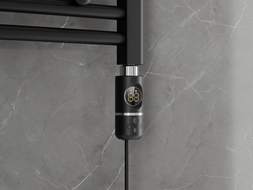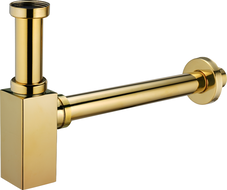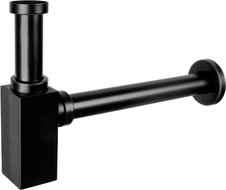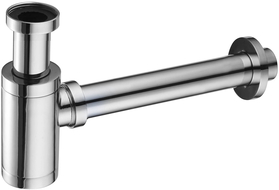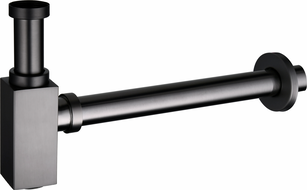
If you look under the sink, you will see a trap - a curved pipe through which dirty water drains into the sewage system. The main secret of the trap lies in its bend. Water does not completely leave the pipe, remaining in this curved section. Thanks to the water seal, unpleasant odors from the pipes cannot enter the room - bathroom, kitchen, or toilet. As you can see, such a trap is a useful solution, right? But how do you install it?
What types of traps fit the sink (and not only)?
In principle, all traps can be divided into the following types:
- mechanical - has a plastic or rubber plug that allows blocking the drainage channel. Here, all manipulations are done manually - without using any levers or automation. The device is very simple, which is why it has a long lifespan.
- semi-automatic - this is a complex structure with a shut-off valve, which is controlled by cable or lever mechanisms. Such regulation is usually placed in the overflow hole above the water level.
- automatic - in this case, the trap is part of the same system with a filling device. A built-in microprocessor controls everything. The system includes an easily operated click-clack valve.
To connect to the bathroom sewage system, just like with any other plumbing fixture, it is necessary to assemble the trap. This is a simple procedure that takes very little time.
Trap – which type to choose and why
The trap is used wherever drainage of water is required. However, its role is not limited to the correct functioning of the sewage system. Visual aspects also come into play. A beautiful, elegant trap can complement a modern bathroom. Usually, a bottle or pipe trap is installed under the sink – these are the most popular types of traps.
When choosing the right trap, we must consider the type of the sink itself. Sometimes, it's worth choosing products from the same manufacturer - usually, a given model has a dedicated type of trap from the same brand. There are traps on the market that have two points for receiving dirty water. Such a model can also be connected to a washing machine if the sewage system does not provide an additional outlet.
Trap Installation – Steps
First, familiarize yourself with the installation diagram included with the purchased trap. It is very important to follow the instructions in the installation manual. Before the actual installation, you should lay out the parts in the order they will be connected. This will also allow you to check whether the set is complete. Sometimes it happens that even in an unopened package, some part is missing. Before the actual assembly, you may assemble the trap "dry" (without installing it in the sink).
Second, prepare the necessary tools. You might need a wrench or a pipe cutter (if we need to shorten them). At that point, also prepare a tape measure and sandpaper to smooth the cut edges of the pipes. If it involves a classic sink, under-counter, or countertop, the trap is installed between the sink's drainage hole and the connection. Its tank is fixed from below while connecting it to the drainage pipe.
Third, at this stage, you should take care of securing all gaskets. It is extremely important that this is done accurately and correctly. During the installation of the trap, all used elements must be dry and clean. Sand or other dirt that falls on the rubber gasket can cause later leaks. Remember not to throw away the packaging of the purchased trap until the installation is complete and the functioning of the installed items has been checked.
Trap Tightness Check
After installing the trap, we can perform a verification check of all connections. To do this, fill the sink with water to ensure that the drainage neck is properly mounted and that all seals are functioning correctly. If there is no water leakage, it means that there were no mistakes during the installation. According to experts, a common cause of leaks is often a misaligned nut connection or insufficient tightening.
Some Helpful Tips for Installing a Trap:
- Before installation of the drainage device, check the diameter and positioning of the drainage pipe.
- When installing the trap, the height of its outlet should be higher than the height of the inlet in the sewage pipe. This way, there will be a certain slope of the pipe that favors water flow.
- When buying a trap, check the quality of the material it is made of. If it is plastic, the thickness of the wall and the processing technology is most important.
- To avoid leaks, seals in the trap should be changed approximately once every six months.
- To prevent limescale buildup on the trap walls, it is advisable to flush it with hot water mixed with citric acid every few months.
A properly installed trap guarantees comfort and peace of mind. Rushing during the self-installation is not advisable. If, after reading detailed instructions, you still have trouble with self-installation, you can watch helpful videos, of which there are many on the internet. If you still find unclear points, it is better to turn to professional plumbers for help.













